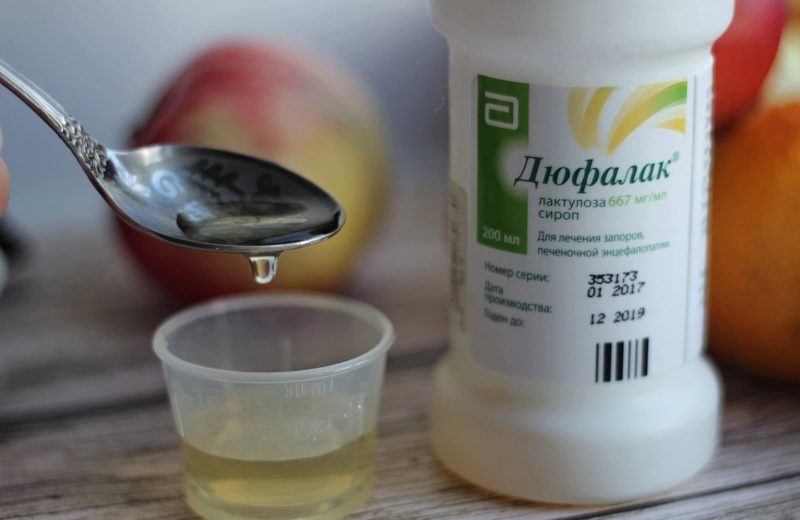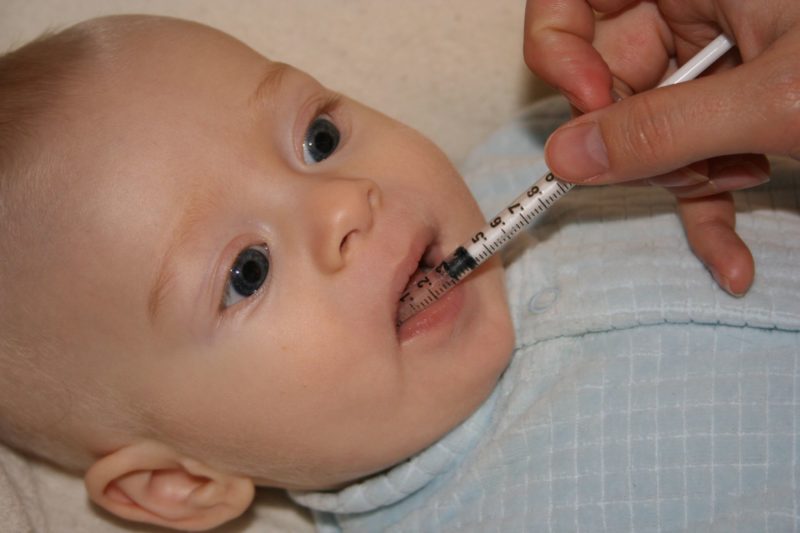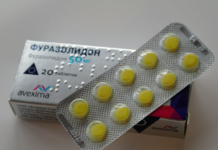Quite often, newborns have various problems associated with the proper functioning of the digestive tract and normal stool. A safe and effective laxative is Duphalac for children, the instruction for use of which states that this therapeutic drug is approved for use even for the smallest patients.
Material Content:
The composition of the drug
The main component that provides the drug effect is lactulose - in 100 ml of a laxative there are 66.7 g of this element. This compound is a product of the processing of whey of milk components. In addition to the main active ingredient, purified water is also included. Due to the maximum safe combination of substances, this laxative is allowed to be used by pregnant women, during lactation, as well as newborn children.
Pharmacological properties and pharmacokinetics
Dufalac acts as a means that consists of a group of prebiotics and has an osmotic mechanism of action. The basis that provides a pharmacological and therapeutic effect is lactulose. This component enters the gastrointestinal tract and does not change, since it is not able to split in its upper parts. Then there is a separation of lactulose into organic compounds, which significantly reduce the pH level and increase the osmotic pressure.Lactulose refers to prebiotic substances due to its ability to actively stimulate the accumulation of lactobacilli, which inhibit the growth and development of pathogenic microorganisms.
The liquefaction of feces is due to the fact that there is an attraction and retention of water molecules, as well as due to a fairly strong osmotic pressure, due to which peristalsis is effectively stimulated. In this case, the elimination of pathogenic microflora, dangerous toxins and various harmful substances that have been in the body for a long time. The active compound is not able to be addictive, accumulate and irritate the mucous membranes. This drug is excreted after cleavage in the intestinal flora of the colon, which is due to the action of bacteria.
What is Dufalac prescribed for children
As a rule, this laxative drug is in demand for constipation, which is caused by a violation of the natural rhythm of defecation for various reasons. In addition to the main purpose, this medicine can be recommended for softening feces, which is often required after surgery.
Dufalac has a fairly extensive range of actions, so it is advisable to take it in the following pathological conditions and disorders:
- Dysbacteriosis
- Constipation
- With hemorrhoids or cracks.
- Salmonellosis (an intestinal infection that affects the digestive tract).
- Shigellosis (intestinal pathological disease of an infectious nature).
- Hepatic encephalopathy.
But also this tool can be used before surgery or a medical examination, for which direct cleansing of the lower intestines is necessary. Often, Dufalac is recommended for patients who need to normalize motility and significantly increase the content of the necessary microorganisms in the intestines.
How long does the drug work?
Lactulose is characterized by the gradual establishment of the gastrointestinal tract and the normal functioning of the intestine. The effect of this laxative is observed after 12 hours, but the drug effect is often achieved only on the second day. However, the therapeutic course of treatment with Duphalac syrup for chronic constipation can reach several weeks.
Instructions for use and dosage
The dosage of Duphalac for children is determined by a specialist who assesses the history and condition of the patient. The medicinal product can be drunk undiluted, as well as mixed with a mixture or milk. The tool must be taken every day, once at the same time of day. According to the instructions, Dufalac should be used in this way:
- For infants up to a year, the dose is determined strictly by the attending physician. As a rule, the amount of funds should not exceed 5 ml per day.
- Children from one year to 6 years old are prescribed no more than 10 ml per day. For proper dosage, use a special cup.
- Children 7-14 years of age are shown 15 ml of the drug for treatment.
- Children under the age of one who suffer from dysbiosis are prescribed 3 ml of the drug per day, patients 4-7 years old - 5 ml per day, children over 7 years old - up to 10 ml at the same time.
- With salmonellosis in the first two weeks of treatment, patients are shown up to 5 ml three times a day. After the course, a week break and analysis is required.
The duration of treatment with this medication directly depends on the diagnosis. As a rule, the therapeutic course does not exceed 20 days.
However, in the event that the child needs a longer treatment with such a drug, in the future he will need to undergo a laboratory blood test for electrolyte levels.
Duphalac is recommended for small patients directly during meals. For the convenience of infants, the laxative is delivered using a small spoon or syringe.After use, the baby should be given breast milk or a special formula for feeding. It is important to note that during therapy, patients should drink plenty of fluids. Under this condition, a laxative will more effectively affect the intestines. It is recommended that children take Duphalac along with massage and exercises.
Drug interaction
According to the results of clinical trials, it was found that the therapeutic result of using Dufalac may decrease during treatment with antibiotic agents and antacids. Based on this, it is recommended to observe an interval of 2 hours between doses of drugs. And it should also be noted that the main active component of a therapeutic agent can significantly increase the level of acidity in the digestive tract, which affects the pharmacological effect of certain drugs that are prescribed to eliminate colitis.
Contraindications, side effects and overdose
Despite the proven safety, Dufalac also has a number of contraindications, in which a laxative cannot be taken:
- intestinal obstruction;
- individual intolerance to galactose or lactulose;
- violation of the normal process of carbohydrate metabolism;
- perforation of the walls of the gastrointestinal tract;
- the presence of an ileostomy or colostomy;
- with caution - with diabetes;
- disturbed lactase production process.
If you do not follow all the instructions and recommendations of your doctor, it is highly likely that some undesirable reactions may occur. The most common side effect of taking Dufalac is flatulence, which occurs in the first days after the start of therapy. And muscle pains, cramps, abdominal cramps, fatigue, diarrhea, dizziness, and nausea are also noted. If negative manifestations are pronounced, the drug should be discontinued.
With improper use of the medication and exceeding the prescribed dose, the risk of developing signs of an overdose is not excluded. In this case, the child may experience a sharp pain in the stomach, diarrhea, loose stools and bouts of vomiting. In such cases, it is necessary to abandon the use of a laxative drug and seek the help of a specialist. It is important to consider that prolonged use of Dufalac in excessive quantities often acts as a cause of a violation of the water-electrolyte balance.
Laxative analogues
Duphalac is not the only laxative medication that is made on the basis of lactulose. To normalize the stool, you can pick up other synonymous drugs that will have a similar effect on the patient's body. The most famous laxatives that have similar composition and pharmacological properties: Normase, Prelax, Lactulose, Portalac, Exportal for children.
It should be remembered that medicines must be replaced only after consulting with your doctor.



















